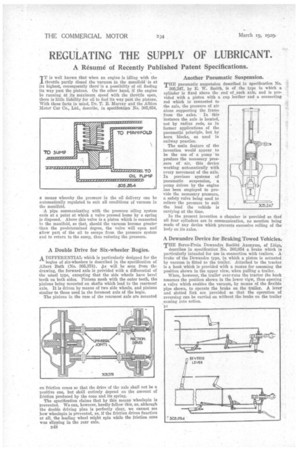REGULATING THE SUPPLY OF LUBRICANT.
Page 74

If you've noticed an error in this article please click here to report it so we can fix it.
A Resume of Recently Published Patent Specifications.
IT is well known that when an engine is idling with the throttle partly closed the vacuum in the manifold is at its highest, consequently there' is a possibility of oil finding its way past the pistons. On the other hand, if the engine be running at its maximum speed with the throttle open, there is little liability for oil to find its way pest the pistons. With these facts in mind, Dr. T. B. Murray and the Albion Motor Car Co., Ltd., describe, in specification No. 305,854,
a means whereby the pressure in the oil delivery can be automatically regulated to suit all conditions of vacuum in the manifold.
A pipe communicating with the pressure oiling system ends at a point at which a valve pressed home by a spring is disposed. Above this valve is a piston which is connected to the manifold, so that, should the vacuum become greater than the predetermined degree, the valve will open and allow part of the oil to escape from the pressure system and to return to the sump, thus reducing the pressure.
A Double Drive for Six-wheeler Bogies.
A DIFFERENTIAL which is particularly designed for the bogies of six-wheelers is described in the specification of Albert Bath (No. 305,378). 4s will be seen from the drawing, the forward axle is provided with a differential of the usual type, excepting that the side wheels have bevel teeth on both sides. Pinions mesh with the outer teeth, the pinions being mounted on shafts which lead to the rearmost axle. It is driven by means of two side wheels, and pinions similar to those used in the foremost axle of the bogie. The pinions in the cast of the rearmost axle are mounted
on friction cones so that the drive of the axle shall not be a positive one, but shall entirely depend on the amount of friction produced by the cone and its spring. The specification claims that by this means wheelspin is prevented. We can, however, hardly follow this, as, although the double driving plan is perfectly clear, we cannot see how wheelspin is prevented, as, if the friction drives function at all, the leading wheel might spin while the friction cone was slipping in the rear axle.
B48
Another Pneumatic Suspension.
THE pneumatic suspension described in specification No. 305,247, by E. W. Smith, is of the type in which a cylinder is fixed above the end °Leach axle, and is pro. vided with a piston with a cup leather and a connecting rod which is connected to the axle, the pressure of air alone supporting the frame from the axles. In this instance the axle is located, not by radius rods, as in former applications of the pneumatic principle, but by horn blocks, as used in railway practice.
The main feature of the invention would appear to be the use of a pump to produce the necessary pressure of air, this device working automatically with every movement of the axle. In previous systems of pneumatic suspension, a pump driven by the engine has been employed to provide the necessary pressure, a safety valve being used to relieve the pressure to snit the load the vehicle is carrying at the. time.
In the present invention a chamber is provided so that all four cylinders are in communication, no mention being made of any device which prevents excessive rolling of the body on its axles.
A Dewandre Device for Braking Towed Vehicles.
THE Servo-Frein Dewandre Societe Anonyme, of Liege,
describes in specification No. 303,054 a brake which is particularly intended for use in connection with trailers. A brake of the Dewandre type, in which a piston is actuated by vacuum is fitted to the trailer. Attached to the tractor is a hook which is provided with a means for assuming the position shown in the upper view, when pulling a trailer.
When, however, the trailer over-runs the tractor the hook assumes the position shown in the lower view, thus opening a valve which enables the vacuum, by means of the flexible pipe shown, to operate the brake on the trailer. A lever and slotted link are provided FM that the operation of reversing can be carried on without the brake on the trailer ..coming into action.




















































































































